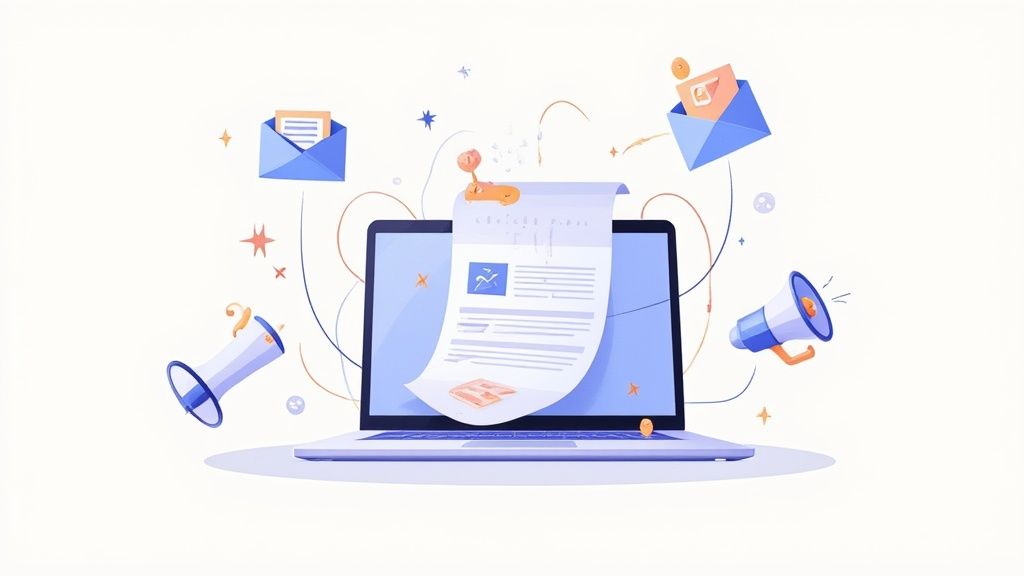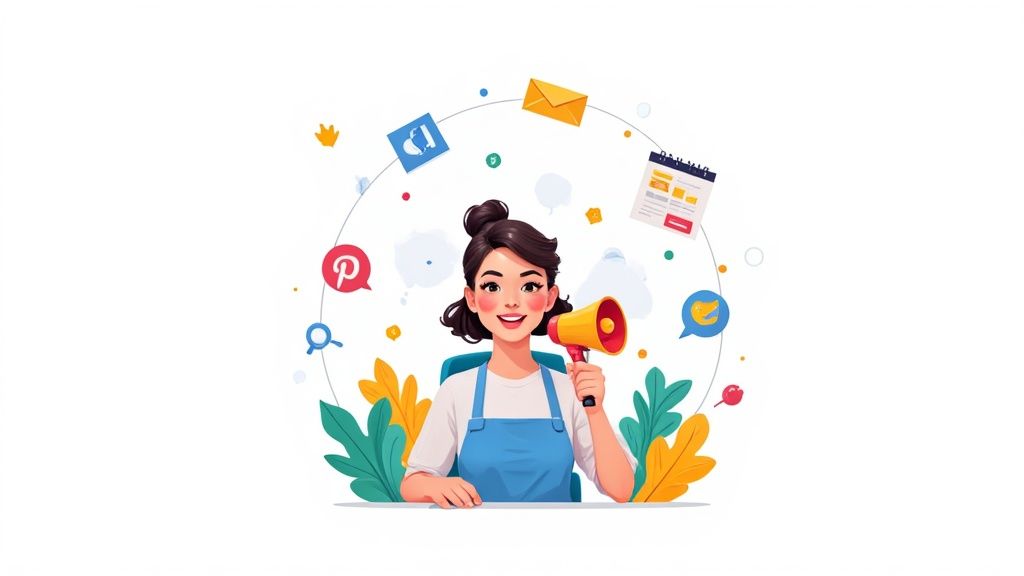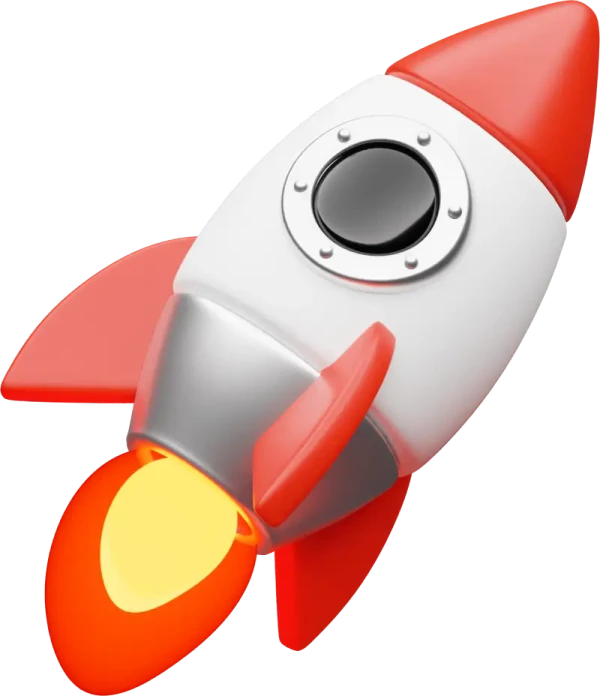Knowing how to promote an event online really boils down to creating a coordinated, multi-channel strategy. It’s not just one thing, but a few core pillars working together: building a killer event page that converts, getting people talking on social media, hitting inboxes with targeted email campaigns, and boosting your reach with paid ads. This is your essential framework for turning casual interest into actual attendance.
Your Blueprint for Successful Online Event Promotion
Promoting an event online isn't about just shouting into the void and hoping for the best. It’s about building a smart plan that reaches the right people, at the right time, with the right message. Think of it like constructing a building—you need a solid foundation before you can even think about decorating the rooms. Your promotion strategy is that foundation.
The first, and I'd argue most critical, piece is your event landing page. This isn't just a simple page with a date and time. It’s your central hub for all information and, most importantly, for getting those sign-ups. This is where potential attendees decide if your event is actually worth their time.
Next up, you've got social media. This is your community-building engine. It's where you create buzz, share behind-the-scenes content, and talk directly with your audience. The goal here isn't just to drop a link and run; it's about starting a conversation that makes people feel connected to your event before it even kicks off.
The Core Channels of Your Promotion Plan
Email marketing gives you a direct line to your most engaged followers. Unlike social media, where you're at the mercy of algorithms, an email lands right in their inbox. This channel is perfect for sharing exclusive details, sending out reminders, and offering early-bird discounts to your loyal community.
Finally, paid advertising is your amplifier. While all your organic efforts build a strong base, paid ads let you reach new, highly targeted audiences who might have never found your event otherwise. It’s how you expand beyond your existing network to fill every last spot.
A winning event promotion strategy is a blend of these channels working in harmony. Your landing page converts, social media engages, email nurtures, and paid ads amplify. Each piece plays a specific role in guiding someone from just hearing about your event to actually registering.
To give this framework a real shot at working, you absolutely must remove any friction in the registration process. This is where a simple tool can make a massive difference.
By integrating an option like our Add to Calendar PRO service directly on your landing page, you make it dead simple for attendees to save the date instantly. That small action turns passive interest into a concrete commitment and can boost your show-up rates significantly. In the sections that follow, we'll dive deep into real, actionable tactics for each of these pillars.
Key Channels for Promoting Your Event Online
To help you visualize how these pieces fit together, here's a quick breakdown of the core channels, their main job, and what you should be measuring to know if they're working.
| Channel | Primary Purpose | Key Success Metric |
|---|---|---|
| Event Landing Page | Converting visitors into registrants. The central hub for all event info. | Conversion Rate (%) |
| Social Media | Building community, generating buzz, and driving traffic. | Engagement Rate, Clicks |
| Email Marketing | Nurturing leads, sharing exclusive updates, and driving registrations. | Open Rate, Click-Through Rate |
| Paid Advertising | Reaching new, targeted audiences and amplifying your message. | Cost Per Acquisition (CPA) |
| Content Marketing | Providing value, establishing authority, and attracting organic traffic. | Organic Traffic, Leads Generated |
| Partnerships | Tapping into new audiences and leveraging third-party credibility. | Referral Traffic, Partner-Sourced Sign-ups |
Think of this table as your strategic cheat sheet. Each channel has a distinct role to play, and by tracking the right metrics, you can see what's firing on all cylinders and where you might need to adjust your approach.
Laying the Groundwork for a Killer Launch
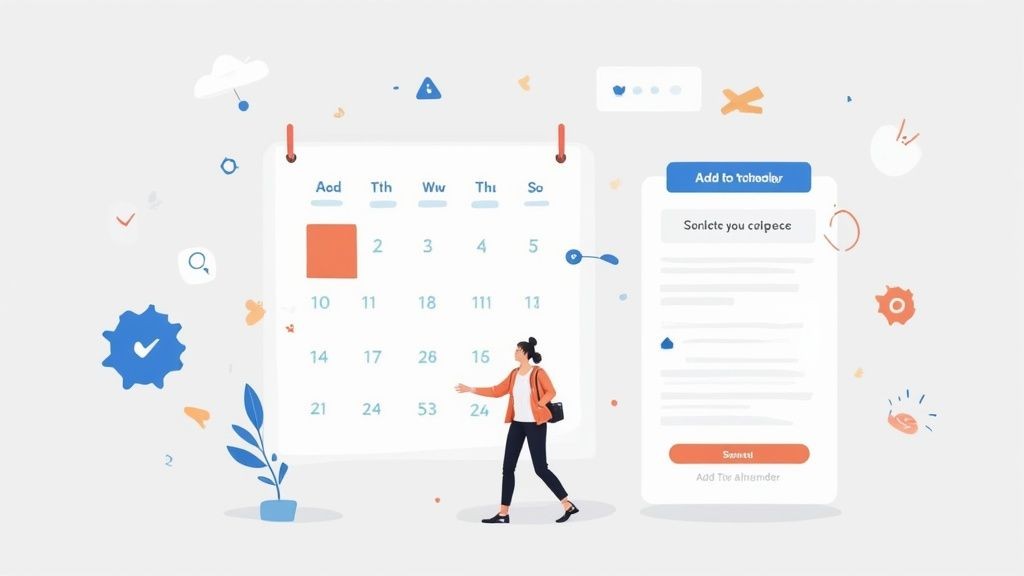
Here's a hard truth: the best online event promotions don't just appear out of thin air. They start with a solid, strategic plan built weeks or even months before anyone even hears about the event. This pre-launch phase is where you do the real work, setting the stage so that when you finally go live, your message hits with maximum impact. It’s all about being proactive, not reactive.
It all starts by answering a single, crucial question: Who are you really talking to? You need to go deeper than surface-level demographics and build out detailed attendee personas. These are your ideal participants, brought to life. What are their job titles? What keeps them up at night? What are they hoping to get out of your event, and where do they hang out online?
Getting this right is a game-changer. It means you can tailor your messaging to speak directly to their pain points and aspirations. For instance, you'd talk to a "Startup CMO" about growth hacks and ROI, while a "Junior Social Media Coordinator" would be more interested in content creation tips. This clarity informs every single piece of promotional material you'll create.
Your Event’s Digital Headquarters
Once you know your audience inside and out, it's time to build your event's home base: the landing page. Don't think of this as just an info dump. It’s your single most important conversion tool, designed to turn a casual visitor into a committed attendee. A sharp, persuasive landing page isn't optional if you're serious about promoting an event online.
This page needs to be the central hub for everything, with all the critical details presented in a way that's easy to digest. Think date, time, a hooky description of the value attendees will get, and a clear schedule. Visuals are massive here—use professional photos or videos from past events or of your speakers to build instant credibility and get people excited. For a deeper dive, we have a complete guide on how to build a high-converting event landing page.
But here’s a pro tip that’s often missed: make it dead simple for people to commit. When someone's interested, you have to capture that intent right away. This is exactly why integrating a call-to-action from our service works so well. A simple "add to calendar" button bridges the gap between passive interest and a concrete plan, dramatically increasing the chances they'll actually show up.
Setting the Stage for Launch
Before a single person visits your page, get your analytics sorted. Set up tools like Google Analytics to track page views, where your traffic is coming from, and—most importantly—your conversion rates. This data is pure gold. It tells you which channels are working so you can double down on what’s effective and cut what isn't.
With your tracking and landing page good to go, you can start building some buzz. This is the teaser phase, not the full reveal.
- Social Media Teasers: Post some behind-the-scenes shots of your team planning. Announce your first speaker with a slick graphic or a short video clip.
- Email Campaign Warm-ups: Send a "save the date" email to your most loyal subscribers, letting them know a big announcement is on the way. It makes them feel like part of an exclusive club.
The pre-launch phase is everything. It sets the entire trajectory for your campaign. By nailing down your audience, building a killer landing page, and creating that initial spark of excitement, you ensure that when you launch, you’re not just starting a fire—you’re pouring gasoline on one that’s already been lit.
Building Buzz with Social Media and Content
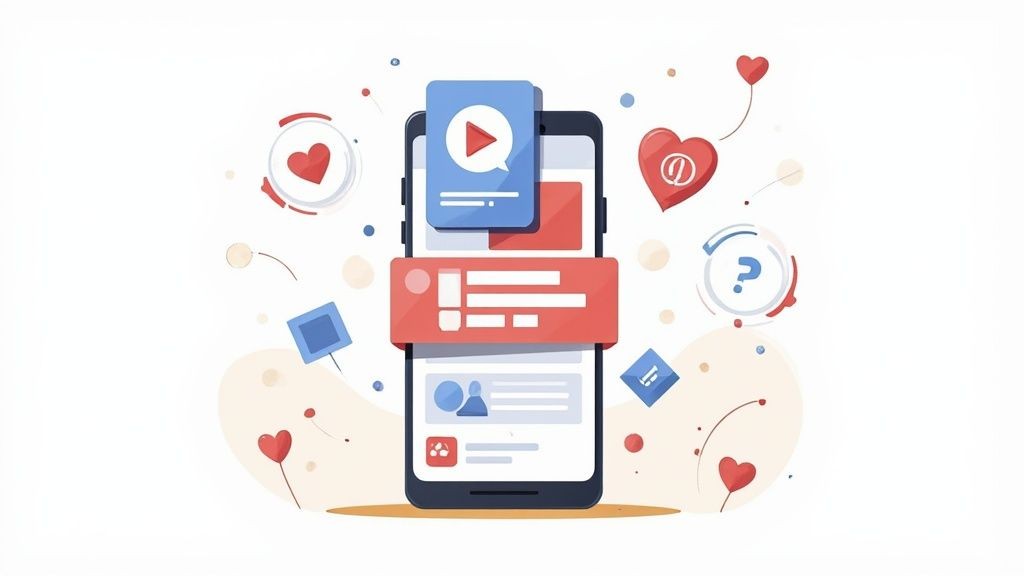
Think of social media as more than just a megaphone—it's your command center for building a real community around your event. Just dropping registration links and hoping for the best is a strategy that died years ago. To get people genuinely excited, you need a content plan that sparks conversation and builds anticipation long before the doors open.
It all starts with picking the right playground. A corporate leadership summit is going to feel right at home on LinkedIn, while a high-energy music festival belongs on Instagram and TikTok. The goal is simple: meet your audience where they already hang out and speak their language.
The data backs this up completely. In 2025, social media is the top choice for 83% of event marketers across the globe. Facebook still reigns supreme with an 86% usage rate, but Instagram (79%) and LinkedIn (65%) are nipping at its heels, proving that a multi-channel approach is non-negotiable.
Crafting Your Content Calendar
A well-structured content calendar isn't just a to-do list; it's your roadmap for building buzz. It keeps your messaging consistent, your content fresh, and your timing perfect for maximum impact. Forget one-off announcements. You should be thinking in terms of a story arc that takes your audience from "What's this?" to "I have to be there!"
To keep people hooked, your content mix needs to be diverse. A good blend of formats will appeal to different tastes and stop your feed from feeling like a broken record.
- Go Behind the Scenes: Post videos of your team in action, speakers prepping their material, or a quick tour of the venue. This stuff humanizes your event and makes people feel like they're on the inside.
- Host Speaker Q&As: Jump on a quick live session or share pre-recorded interviews with your headliners. It’s a great way to show off their expertise and give attendees a preview of the value they'll get.
- Create Countdown Graphics: Use eye-catching visuals and Instagram Stories to mark milestones—one month out, one week to go, 24 hours left. This creates a tangible sense of urgency.
The best social media promotion isn’t about selling a ticket—it's about selling an experience. Your content needs to give people a serious case of FOMO (Fear Of Missing Out), making them feel like they’ll miss something amazing if they don't show up.
Engaging Your Community Authentically
Engagement is a two-way street. Your strategy needs to pull your audience into the event's narrative. User-generated content (UGC) campaigns are brilliant for this because they turn your attendees into your most passionate advocates.
You could, for instance, run a contest asking people to share why they're excited for the event using a unique hashtag. Offer a cool prize like a VIP upgrade or a one-on-one with a speaker. This doesn't just generate a ton of authentic promotion; it explodes your reach. Our detailed guide offers more hands-on tactics on how to promote your event on social media to get this kind of community buy-in.
And please, don't just post and ghost. Make it a point to monitor comments, answer questions promptly, and reshare the best posts from your followers. It shows you're actually listening.
Expanding Beyond the Feed
While social media is your go-to for direct engagement, a solid blog is your secret weapon for pulling in an organic audience from search engines. This strategy sets you up as a trusted authority, not just another event host.
Get inside the head of your ideal attendee. What are they Googling? If you're promoting a wellness retreat, you could publish articles like "5 Mindfulness Techniques to Beat Stress" or "The Real Benefits of a Digital Detox."
This kind of content does two things at once:
- It attracts the right people: You're drawing in an audience that's already deeply invested in your event's core themes.
- It builds trust: By giving away valuable information for free, you establish credibility. When it comes time to ask for a registration, they're already warmed up.
Every blog post should have a natural call-to-action that points back to your event, positioning it as the perfect next step. This turns your promotion from a simple sales pitch into a value-packed invitation that attracts a highly qualified and motivated crowd.
Expand Your Reach with Email and Partnerships
Social media is great for casting a wide net, but email marketing is your direct, personal line to the people who are already listening. These are your warmest leads—the ones who've already said, "Yes, tell me more." This is where you can turn casual interest into a confirmed registration.
But why stop with your own audience? To really give your event a fighting chance, you need to look beyond your own bubble and tap into new communities through smart partnerships.
Think of it this way: your email list is your inner circle, and partnerships are like getting a trusted introduction to a whole new group of potential attendees. You absolutely need both.
A lot of people make the mistake of treating email as a one-and-done announcement. To actually get results, you need a thoughtfully planned email sequence that builds excitement over time. It’s a story that unfolds right in your subscriber's inbox.
Designing a High-Impact Email Sequence
The secret to a killer email campaign is sending the right message at the right time. Ditch the single generic blast and map out a series of emails that guide people from "What's this?" to "I have to be there."
A solid sequence usually looks something like this:
- The Big Reveal: This is your kickoff. Make it exciting and focus on the core value. Announce your theme or a huge keynote speaker and drive everyone straight to your event page.
- The Early-Bird Offer: Nothing creates urgency like a discount. Reward your most loyal followers with an exclusive, limited-time price. Make it clear this is their chance to get the best deal.
- Spotlight & Social Proof: Dedicate entire emails to specific speakers, can't-miss sessions, or unique perks of attending. Sprinkle in testimonials from last year's attendees or powerful quotes from your speakers to build trust.
- The Agenda Deep-Dive: Give them the full schedule. When people can see exactly what the day looks like, it helps them visualize the experience and justify the time away from the office.
- "Last Chance" Nudges: In the final days before registration closes, send a couple of reminders. Use clear, direct subject lines like "Ends Tonight" or "Last Call" to push those final sign-ups over the line.
Email isn't just a bullhorn; it's a conversation. Personalize your messages, speak directly to what your audience cares about, and always give them a compelling reason why they absolutely can't afford to miss your event.
And the data backs this up. Email marketing is still a beast for event promotion, boasting an impressive average open rate of 32.55% across industries. Even more telling? 64% of consumers are more likely to pay attention when brands tailor their messages. You can dig into more of these event industry trends and how to apply them.
Tapping into New Audiences with Partnerships
Why do all the heavy lifting yourself? Strategic partnerships are one of the smartest ways to promote an event online. They give you instant access to new, highly relevant audiences who already trust the source. It’s all about finding that perfect win-win.
Start by brainstorming potential partners whose audience looks a lot like your ideal attendee, but who aren't direct competitors.
- Complementary Brands: Hosting a digital marketing conference? A company like HubSpot or another CRM provider would be a perfect fit.
- Industry Influencers: Find the respected voices in your niche. Offer them a free ticket or even a speaking slot in exchange for a shout-out to their followers.
- Media Publications and Blogs: Pitch your event to industry-specific blogs or online magazines. A feature article or guest post can put you in front of thousands of fresh eyes.
The key to a successful pitch is making it a no-brainer for them. Don't just ask for a favor; spell out what's in it for them. Maybe it’s co-branding opportunities, a cut of ticket sales, or exposure to your audience.
For a complete playbook on crafting these kinds of campaigns, check out our deep dive into email marketing for events. By pairing a direct email strategy with the expanded reach of partnerships, you create a powerful promotional engine that pulls in sign-ups from both your core community and entirely new networks.
Using Paid Ads to Target and Retarget Attendees
Organic promotion is great for building a solid foundation, but if you want to sell out your event, paid advertising is the rocket fuel you need. While your social media and email lists are perfect for engaging your core community, paid ads let you break through the noise and reach thousands of potential attendees who would otherwise never even know you exist.
The real magic of platforms like Facebook, Instagram, and LinkedIn is the insane level of targeting you can achieve. You’re not just shouting your message from a rooftop; you're whispering it directly into the ear of the person most likely to buy a ticket. This is where you go from just promoting an event to strategically filling seats.
This precision is exactly why confidence in digital advertising keeps climbing. In fact, social media ad spend is projected to jump by another 11.9% in 2025. That’s a clear signal that businesses are seeing a real, measurable return. You can dig into more of these event industry statistics and see what they mean for marketers here.
Building Your Ideal Audience
Before you even think about spending a dollar, you need to be crystal clear on who you're trying to reach. The most powerful ad platforms give you a whole toolbox of targeting options to zero in on your ideal attendee.
Here are a few of the most effective strategies to start with:
- Lookalike Audiences: This is easily one of the most powerful tools in your marketing arsenal. You upload a list of your current registrants or past attendees, and the platform’s algorithm goes out and finds new people with shockingly similar characteristics and online behaviors. It’s like cloning your best customers.
- Interest and Behavior Targeting: This is where you can get really creative. Think about what your audience actually cares about. You can target people based on the pages they follow, the software they use, or even their purchasing habits. Hosting a marketing conference? Target users who follow industry leaders like Seth Godin or who have shown interest in tools like HubSpot.
- Job Title and Industry Targeting: For B2B events, this is pure gold, especially on LinkedIn. You can put your ads directly in front of people with specific job titles, at specific companies, or within a niche industry. Need to reach VPs of Sales in the SaaS world? No problem.
The goal of paid advertising isn't just to get clicks; it's to get the right clicks. A well-targeted campaign puts your event in front of a qualified audience, which means a higher conversion rate and a much better return on your ad spend.
The Power of Retargeting
Have you ever looked at a pair of shoes online, only to see ads for those exact shoes following you everywhere? That’s retargeting, and it’s an event marketer's secret weapon.
Let’s be real: people get distracted. They’ll land on your event page, their dog will start barking, and they'll close the tab without signing up. Retargeting is your second chance to bring them back into the fold.
By placing a small piece of code (often called a pixel) on your website, you can build a custom audience of everyone who visited your event page but didn’t register. From there, you can serve them a specific set of ads designed to nudge them over the finish line.
For example, your retargeting ad could feature a powerful testimonial from last year's event, highlight a keynote speaker they can't afford to miss, or create a little FOMO by reminding them that early-bird pricing ends Friday. The data doesn't lie: retargeted ads can have click-through rates 10 times higher than standard display ads. This one strategy can honestly be the difference between a half-empty room and a sold-out event.
Keeping the Momentum Going During and After
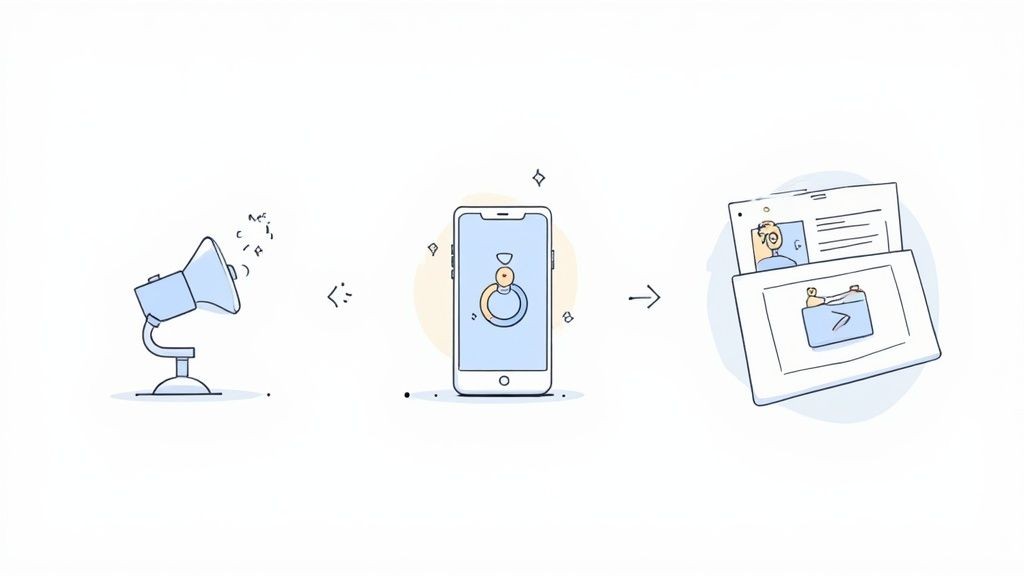
A lot of organizers breathe a sigh of relief once the event kicks off, thinking the hard part is over. But that’s a rookie mistake. The promotion doesn’t stop when the doors open—it just shifts gears. Now's your chance to broadcast the live experience and start turning a single event into a long-term community.
Your main goal during the event is to dial up the FOMO (Fear Of Missing Out) for everyone who couldn't make it. This isn't about making people feel bad; it's about showing them exactly what they're missing so they'll be first in line for the next one.
Engaging Your Audience in Real-Time
Treat your social media channels like you're a live correspondent on the scene. When you share key moments as they unfold, your attendees become your stars, and your online followers turn into an audience that’s already hyped for your next event.
- Live-Tweet Key Insights: Pull out powerful quotes, surprising stats, and big takeaways from your speakers. Make sure you tag them—it’s a simple way to get retweets and expose your event to their entire network.
- Use Instagram and Facebook Stories: This is perfect for the raw, in-the-moment stuff. Post quick video clips from sessions, show some behind-the-scenes action, or grab a few attendees for a quick reaction shot. Stories feel authentic and urgent.
- Stream a High-Value Segment: Thinking of going live? Pick a chunk of your most anticipated keynote and stream it on Facebook or LinkedIn. Giving non-attendees a genuine taste of the value you're delivering is an incredibly powerful teaser.
The energy of a live event is your most valuable marketing asset. By capturing and sharing it, you're not just reporting on what's happening; you're creating a compelling narrative that makes people wish they were there.
Nurturing Your Community After the Event
Once the last person has left, your job shifts from promotion to relationship-building. You've made a ton of valuable connections, and a solid follow-up plan is absolutely essential to keep that momentum from fizzling out. This is where you lock in attendee loyalty.
Your very first move? Send a thank-you email within 24 hours. This isn't just good manners; it's your first opportunity to provide post-event value. Include links to session recordings, presentation slides, or any other resources you mentioned. It immediately proves the event’s benefits last long after the closing remarks.
Next, it's time to slice and dice all that great content you captured.
- Create Photo Galleries: Upload a curated album to Facebook or your blog. The magic happens when you encourage people to find and tag themselves, which blasts your event photos across their personal networks.
- Produce a Highlight Reel: Stitch together the most exciting moments into a punchy, 1-2 minute video. This instantly becomes your #1 marketing asset for future events.
- Share Testimonials: Did you get some glowing feedback? Ask for permission to use it, then turn those quotes into slick graphics. There's no better social proof for your next campaign.
This kind of consistent follow-up does more than just wrap things up. It strategically lays the foundation for your next success, keeping your audience hooked and ready for whatever you have planned.
Burning Questions About Promoting Events Online
Even with the best-laid plans, a few questions always seem to pop up when you're in the thick of promoting an event. Let's tackle some of the most common ones we hear from fellow organizers.
How Far in Advance Should I Actually Start Promoting?
This is the classic "it depends" question, but the answer really hinges on the scale of your event. If you're planning a big conference or a trade show, you need to start the promotional engine 4-6 months out. That's your runway for building real momentum, locking in those crucial early-bird sales, and getting partners on board.
But for a smaller affair, like a webinar or a local workshop? A much shorter timeline of 4-6 weeks is usually plenty. The most important thing isn't the exact timeline, but making sure your core assets—especially your landing page—are rock solid before you start shouting about it from the rooftops.
What’s the Single Biggest Mistake Organizers Make?
Easy. It's blasting the exact same, generic message across every single platform. What resonates on LinkedIn will absolutely tank on Instagram. You have to speak the language of the channel.
A data-heavy, professional update is perfect for LinkedIn, where you’re in a business mindset. Over on Instagram, you need something that grabs attention instantly—think behind-the-scenes video clips or a snappy countdown graphic. Customizing your content isn't just a nice extra; it's the only way to cut through the noise.
Your goal isn't just to be seen; it's to be remembered. That only happens when you respect the unique culture and format of each platform your audience calls home.
How Do I Know If Any of This Is Actually Working?
You need to focus on the metrics that tie directly back to your event goals for each specific channel.
For your website, the number one metric is your landing page conversion rate. With email, you should be tracking open rates, sure, but the real gold is in the click-through rates that lead straight to a registration.
On social media, look past the vanity metrics like likes and focus on genuine engagement and reach. Here’s a pro tip: Use UTM parameters in all your promotional links. This little trick lets you see exactly which channels, campaigns, and even specific posts are driving the most sign-ups. It gives you crystal-clear data so you can stop guessing and start doubling down on what truly works.
Make every promotion count by turning interest into actual attendance. Our service makes event marketing simpler with beautiful, reliable Add to Calendar buttons, RSVP forms, and shareable landing pages that are proven to boost your show-up rate. See how our service can help you get more people to your events.
